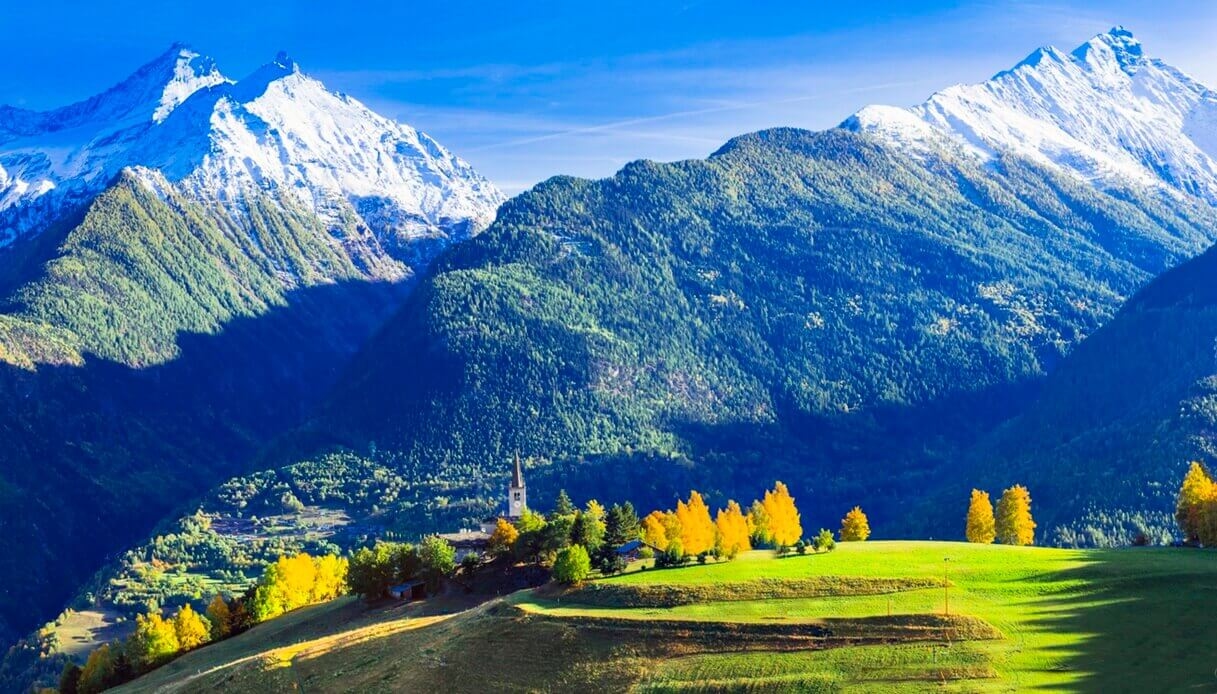Aosta Valley: ancient paths wind through Alpine panoramas and absolute tranquility.

The Aosta Valley is Italy's smallest region, but despite its modest size, it holds a myriad of treasures for visitors. Perhaps this is why in the summer it is swarmed with tourists from Italy and other European countries who flock to enjoy its mountains, its incredibly blue skies, its castles, and the other attractions of this truly rich region.
Then, as the months pass, the crowds fade, but the beauty remains. Indeed, in autumn, the region in the far northwestern corner of Italy offers something different, unique, and too often overlooked. It's often the perfect season to rediscover a slower pace, walking along the decades-old paths that have long connected small villages, mountain pastures, and various mountain passes. It's an irresistible invitation for those who love the mountains, nature, and sweeping panoramas, the kind that fill the gaze with wonder.
What to do in the Aosta Valley in autumnAutumn in the Aosta Valley offers a myriad of experiences. Naturally, outdoor activities remain a key focus even when it's no longer summer. In fact, walks through the woods and chestnut groves are certainly even more evocative than in the warmer months.
This is thanks to the myriad colors of foliage , with the larches that characterize the mountain slopes, which light up a spectacular golden yellow in October. In the valleys surrounding Gran Paradiso, spectacular views await, following trails that often lead to sightings of the splendid fauna that populates the mountains.
With fewer tourists, autumn is also perfect for exploring the many medieval castles dotting the valley: Fénis is a spectacular manor house, unusually located in a position devoid of natural defenses, while Verrès and Ussel stand atop rocky promontories. Also not to be missed are Issogne Castle, with its magnificent frescoes in the portico, and the Royal Castle of Sarre , with its sumptuous interiors, a legacy of the Savoy family.
In autumn, the streets of villages, towns, and villages are often filled with local festivals and celebrations. One example is the désarpa , the traditional celebration celebrating the return of herds from the mountain pastures at the beginning of autumn. This festivity is celebrated in several towns, with historical processions, costume parades, and tastings of typical products. Those in Morgex and Valtournenche are among the most renowned. The entire autumn season is also characterized by agricultural fairs, markets, and village festivals.
Autumn is also the ideal season to savor traditional flavors. Aosta Valley cuisine is hearty and authentic: juicy polenta concia, characterized by the flavors of local cheese; the stew called carbonada , featuring meat, onions, and red wine; the classic fondue, the star of the local table; and the hearty Valpellinentze soup, with cabbage, fontina cheese, and lard.
Aosta Valley cuisine is also characterized by a variety of traditional cured meats, with distinctive and often surprising flavors, such as boudeun (a sausage made from potatoes, lard, pork blood, and spices), saouseusses (cured beef sausages), and motzetta (a beef or horse bresaola flavored with mountain herbs). Of course, the true stars of the table are the region's cheeses, especially Fontina, accompanied by local wines: the quality of the whites is well-known, but the reds are unfairly underrated.
Autumn in the Aosta Valley: excursion suggestionsAutumn brings shorter days, more changeable weather, lower temperatures, and the first snowfall. However, it's still a fantastic season to enjoy the mountains using the oldest means of transport of all: our feet.
Walking along the many possible itineraries in the Aosta Valley, you can discover sensational panoramas, admire the soaring peaks already blanketed in snow, and pass through forests transformed into a kaleidoscope of colors.
Balteo WayThe Cammino Balteo is a route over 350 kilometers long that traverses the entire middle and lower Aosta Valley, passing through 48 municipalities and offering different views at each stage. It's a low-altitude route, ideal in autumn, when the landscapes are ablaze with warm colors and the days are still mild.
You can obviously choose how much of the Camino to tackle and which of the many places of interest you pass through to admire: the medieval castles or the vineyards, the mule tracks that connect the mid-mountain villages or the mountain panoramas on the highest peaks in the region.
The chestnut trees of MachabyThe sanctuary of Notre Dame des Neiges and the village of Machaby , just 700 meters above sea level, are the destination of a truly ideal excursion for autumn, because all around the religious building and the small hamlet there are centuries-old chestnut woods that in this season are transformed into a mosaic of golden hues.
The route, easy and suitable for everyone, starts from the charming village of Arnad, which is worth a visit in itself and is known for its Lardo d'Arnad . In a couple of hours, you climb through the burnished chestnut groves to the sanctuary and the village.
At the entrance to Machaby, moreover, there is a fascinating archaeological site: here is kept the so-called fertility stone , a megalith linked to ancient Celtic magical rituals that were said to prevent sterility in women who slipped on it.
From Donnas to BardA short but fascinating itinerary connecting two of the most characteristic and well-known villages in the lower Aosta Valley: Bard , with its imposing 19th-century fortress, and Donnas , crossed by the Via delle Gallie, the Roman road still perfectly visible.
The easy route follows the traces of the ancient Roman road, passing sections carved into the rock and the monumental arch that marked the entrance to the town of Donnas. It's a long walk suitable for everyone, lasting about two hours, and is especially suited to those who want to immerse themselves in two thousand years of history and those who enjoy a slower pace. You can complete the excursion with a visit to the Bard Fortress , now home to the Alpine Museum.
The Blue Lake in Val d'AyasThe Blue Lake is one of the most popular destinations in the Aosta Valley, whatever the season. In autumn, if the weather is favorable, you can enjoy a visit in profound silence.
The reservoir is located at over two thousand meters above sea level, above Saint-Jacques-des-Allemands , in the municipality of Ayas. From here, the trail begins, which takes about two hours to complete, gently climbing through golden forests and wide pastures dotted with wooden huts. Finally, you reach the lake, nestled in a lunar, rocky landscape between two stony moraines. Here, the crystal-clear water beautifully reflects the mountain peaks, the clouds, and the sky above.
siviaggia





